|
 Helicogloea lagerheimii Helicogloea lagerheimii
BiostatusPresent in region - Indigenous. Non endemic
Images (click to enlarge)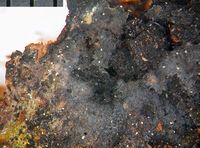
Owner: J.A. Cooper | 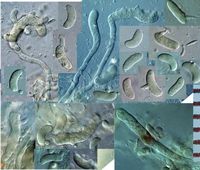
Owner: J.A. Cooper | 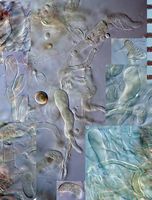
Owner: J.A. Cooper | 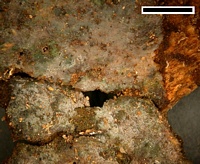
Caption: scale=4mm
Owner: J.A. Cooper | 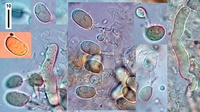
Owner: J.A. Cooper | 
Caption: Helicogloea lagerbeimii: d, basidium; e, developing basidia with
saccate probasidia; f, germinating spore; g, spores, (All x 1000 approx.) |
Article: McNabb, R.F.R. (1964). New Zealand Tremellales - I. New Zealand Journal of Botany 2(4): 403-414 (http://www.rsnz.org/publish/abstracts.php).
Description: Fructifications soft-gelatinous, indeterminate,
greyish hyaline when fresh, drying to a dusky, varnish-like film, effused, forming
areas up to 10 cm in extent, surface tuberculate or corrugated. Internal hyphae
septate, often constricted at septa, walls slightly thickened, to 8 µm. diam.,
clamp connections absent. Probasidia arising laterally from terminal primordial
cells, thin-walled, saccate, oblong-ovoid, 20-32 x 7.5-11.5 µm. Metabasidia
arising terminally from primordial cells, narrow then enlarged distally, transversely
3-septate, 67-105 x 7.5-9 µm, sterigmata to 10 µm long. Basidiospores curved-cylindrical
to ovate-ellipsoid, hyaline, bluntly apiculate, 14-18.5 x 7-9 µm. Germination
by repetition.
Habitat: Angiosperm bark and wood.
Notes: Helicogloea lagerheimii is the most variable species in the genus. Baker (1936, p. 97) gave
the range in spore size as 8-18 x 4-9 µm., and later (Baker 1946, p. 631) as
8-25 x 4-13 µm. Olive (1948, p. 588) described a collection with spores 22.6-29.6
x 8.7-12.2 µm., thus extending the range even further.
Production of additional basidia by proliferation
of the subterminal cells is a common occurrence in the New Zealand material.
|